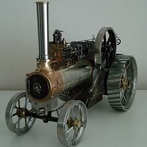Leaderboard
Popular Content
Showing content with the highest reputation on 09/14/2018 in all areas
-
2 points

C-120 is going to another home soon
Cub Cadet and one other reacted to Anglo Traction for a post in a topic
Having a clear out of the workshop and this is the first of the machines to go. In the process of installing a later Transmission. Why ?, well the old original one (5091 version) developed a tiny weep on the r/h axle seal and we all know they don't cure themselves. I suspected a worn needle bearing, so I checked it for up and down sloppy movement, as I won't sell it like that - Barely 0.007" up and down total with all the weight taken on the Jack, which is not that bad. I'm not happy just replacing the seal, so I'm going to rebuild this one and install the 103916 unit which is unmolested, clean shafts 'n' keyways, no leaks and had clean oil drained out of it- It will be used for mowing and towing duties, so it will have a heavy duty WH tow hitch fitted. Old tranny is on the left, replacement should be fitted this evening and I'll make the new woodruff keys over the weekend hopefully (in between watching Singapore GP)- -
2 points

Plough Depth Wheel'
Cub Cadet and one other reacted to Stormin for a post in a topic
Had a good day in the workshop today. Got the swivels finished. Turned down to fit through the arm and drilled and tapped for securing bolts. Forgot to take a photo. Spent sometime thinking how and where to mount them. Eventually decided where on the arm and then rigged up a temporary mount for the top one. Couple of nuts with the corners turned off to clear the arm. They will be pinned. I can set the depth down to 8-1/2 inch. Plenty deep enough and I very much doubt I'll plough that deep. -
1 point

Here is my winter project
Anglo Traction reacted to callander ploo-man for a post in a topic
This is my next project anybody know what kind of mower this is and what type of engine is fitted -
1 point

Fichtel & Sachs AG STAMO 202
pmackellow reacted to Anglo Traction for a post in a topic
Sorry for delay in reply. Nope, not a chainsaw. It is a Mower, but I don't think they are common in UK?. It was a bit of a wreck and on it's second engine (1965 mower model). Judging by the damage to the rather massive Spindle housing, it had a catastrophic bearing failure as well when the original engine let go of it's bits. Presumably, it had new bearings fitted when the engine was replaced, and it was these bearings which had also failed and I was tasked with extracting them for replacement- It took an awful lot of pressure just to get the 25mm diameter spindle out. I then had the same problem with the bearings and found they had been bonded in to take up the gap caused by the old seized ones wearing the Housing bore out- Found the housing bore was nearly 0.4mm larger after cleaning it out. That gave me a problem, as the usual Loctite bearing fit fluids could only cope with much smaller gaps. Searched and found one that specified use for up to 0.5mm gaps, obtained new quality bearings and had to make a circular wire spacer to hold the lower bearing away from a worn lip in the bottom of the housing- Reassembled and bolted up under tension to ensure everything was aligned while the joint fluid was setting. Installed the completed Housing back onto the Deck and fitted the massive sharpened/balanced blade. All now smooth spinning ready for running- It was then that I had to tear into the engine to find why no spark. Not impressed with the motor's design, over complicated and lots of work removing bits to get at the coil etc. Took a 4 foot (1.22mtrs) scaffold bar on both the Flywheel nut and then again to get the Flywheel off the keyed taper. Anyway, all sorted and got it running despite the iffy Carb (now you know where that Fuel Tap I fixed went to)- This machine had a serious impact on it's left rear corner. You can just see the (good) Ali weld repair bottom right. It had damaged the Drive unit housing etc and I had to pull that straight and fix the pulleys etc- So there it is, a 1965 SABO rotary mower with drive unit. I only have to fix the handles on and it's ready for testing and fine tuning. It has no remote throttle on the handle, only a lever that lifts the drive unit clear of the ground!. The throttle lever is on the Carb!. Interesting machine and a mildly enjoyable challenge, but give me an old british job with old whitworth spanners and a good chance of obtaining spares and info. Which spookily is what is lined up for me next edit- Mods can move this to another forum as it is a pedestrian op machine if desired. I kept it here for continuity Regards -
1 point

help needed
HeadExam reacted to Anglo Traction for a post in a topic
Welcome to the Forum. I other thing to check before buying any parts is to check all earth/ground connections in the Ignition circuits. Your Tractor model commenced in 1979 and has (should have) an Engine cradle with Anti vibration mounts. It calls for a cable to be fixed to an engine point and the cradle in order to maintain a good earth(ground) to make the circuits.They need to be clean metal contact. Diagram of the link cable (47) example for you- If any become rusted, the resistance increases and subsequently reduces current flow. This can restrict the current from the Coil, through the S/Plug to earth/ground. Earth/Ground connections include Solenoid, Condenser bodies, as well as the engine to frame. If the Starter motor spins the engine over ok, then that cradle to engine earth wire is proving a good connection, so you can check the other items mentioned If this doesn't help with the spark strength, then you may have to replace some parts. If you have a multimeter, you can test most of the parts and connections to see what you need. You can also set the static ignition timing accurately with it too. -
1 pointObtained some threaded bar yesterday from the farm workshop. So this morning I made the adjuster. A piece of round bar with one end drilled and tapped 22mm x 25mm deep. The other end drilled to suit some 3/8 black bar bent to form a handle. The threaded bar was then screwed in and secured with a dowel. I then started on a couple of swivels for the adjusting screw to pass through. One with clearance hole and one tapped out 12mm. Couple of pieces of 1" dia. offcuts out of the scrap box would do the job. Problem was how to drill through the bar. My bench drill won't take sleeve drills. Then I had an idea. Faced off the ends, then put a small centre pop where I wanted to drill. Next fitted the four jaw chuck in the lathe and using a centre in the tail stock, aligned the pop mark with that. The first piece was drilled and tapped. The thread started in the lathe and finished in the vice. Bingo! More lathe work to be done another day.
